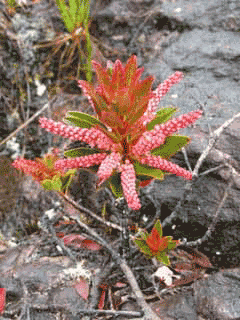 |
|
http://de.wikipedia.org/wiki/Benutzer:ChristianHu |
 |
| USDA-NRCS PLANTS Database / USDA NRCS. Wetland flora: Field office illustrated guide to plant species. USDA Natural Resources Conservation Service. |
Translate this page:
Summary
Bloom Color: White.
Main Bloom Time: Early summer, Late summer, Mid summer. Form: Irregular or sprawling, Oval.
Physical Characteristics

 Cyrilla racemiflora is a deciduous Shrub growing to 1.2 m (4ft) by 2 m (6ft 7in) at a slow rate.
Cyrilla racemiflora is a deciduous Shrub growing to 1.2 m (4ft) by 2 m (6ft 7in) at a slow rate.
See above for USDA hardiness. It is hardy to UK zone 5. It is in leaf from April to October, in flower from August to October, and the seeds ripen from September to November. The species is hermaphrodite (has both male and female organs) and is pollinated by Bees.
Suitable for: light (sandy) and medium (loamy) soils. Suitable pH: mildly acid and neutral soils. It cannot grow in the shade. It prefers moist soil.
UK Hardiness Map
US Hardiness Map
Synonyms
C. parviflora. Raf.
Plant Habitats
Woodland Garden Sunny Edge;
Edible Uses
References More on Edible Uses
Medicinal Uses
Plants For A Future can not take any responsibility for any adverse effects from the use of plants. Always seek advice from a professional before using a plant medicinally.
Astringent Styptic
The spongy bark at the base of the trunk is pliable, absorbent and astringent. It has been recommended as a styptic[82].
References More on Medicinal Uses
The Bookshop: Edible Plant Books
Our Latest books on Perennial Plants For Food Forests and Permaculture Gardens in paperback or digital formats.

Edible Tropical Plants
Food Forest Plants for Hotter Conditions: 250+ Plants For Tropical Food Forests & Permaculture Gardens.
More

Edible Temperate Plants
Plants for Your Food Forest: 500 Plants for Temperate Food Forests & Permaculture Gardens.
More

More Books
PFAF have eight books available in paperback and digital formats. Browse the shop for more information.
Shop Now
Other Uses
Wood
Wood - heavy, hard, close-grained, not strong[82].
Special Uses
References More on Other Uses
Cultivation details
Landscape Uses:Hedge, Standard, Woodland garden. Requires a sunny position and a humus-rich soil[200]. Thrives in a mixture of peat and loam[11]. Prefers a circum-neutral or slightly acid, moisture-retentive soil[200]. This species has a wide distribution in the wild, extending southwards from South-eastern North America to Brazil. An evergreen small tree in the warmer parts of its range, only those forms from the most northerly part of its range can be grown outdoors in Britain. These northerly forms are deciduous, though may remain evergreen in mild winters[11, 200]. They usually take the form of a small shrub, but can sometimes become a small tree. They succeed outdoors in the south of Britain, though can be damaged or killed in severe winters[11]. The flowers are produced at the base of the current years growth[11, 200]. Special Features:Attractive foliage, North American native, Naturalizing, Wetlands plant, Fragrant flowers, Attractive flowers or blooms
References Carbon Farming Information and Carbon Sequestration Information
Temperature Converter
Type a value in the Celsius field to convert the value to Fahrenheit:
Fahrenheit:
The PFAF Bookshop
Plants For A Future have a number of books available in paperback and digital form. Book titles include Edible Plants, Edible Perennials, Edible Trees,Edible Shrubs, Woodland Gardening, and Temperate Food Forest Plants. Our new book is Food Forest Plants For Hotter Conditions (Tropical and Sub-Tropical).
Shop Now
Plant Propagation
Seed - best sown as soon as it is ripe in a greenhouse[200]. As soon as they are large enough to handle, prick out the seedlings into individual pots. Grow them on in the greenhouse for at least their first winter, planting them out in early summer when there is no danger of frost. Give them some protection from the cold for their first winter outdoors. Cuttings of softwood, spring in a frame[200]. Cuttings of half-ripe wood, July/August in a frame[200]. Root cuttings in the spring[200].
Other Names
If available other names are mentioned here
Native Range
NORTHERN AMERICA: United States (Alabama (south), Florida, Georgia, Louisiana, Mississippi (south), North Carolina (east), South Carolina, Virginia (southeast)), Mexico (Oaxaca) SOUTHERN AMERICA: Hispaniola, Cuba, Dominica, Guadeloupe, Jamaica, Martinique, United States (Puerto Rico), St. Vincent and Grenadines, Belize, Nicaragua (northeast), Panama, Guyana, Venezuela (south), Brazil (north), Colombia (east)
Weed Potential
Right plant wrong place. We are currently updating this section.
Please note that a plant may be invasive in one area but may not in your area so it's worth checking.
Conservation Status
IUCN Red List of Threatened Plants Status :

Growth: S = slow M = medium F = fast. Soil: L = light (sandy) M = medium H = heavy (clay). pH: A = acid N = neutral B = basic (alkaline). Shade: F = full shade S = semi-shade N = no shade. Moisture: D = dry M = Moist We = wet Wa = water.
Now available:
Food Forest Plants for Mediterranean Conditions
350+ Perennial Plants For Mediterranean and Drier Food Forests and Permaculture Gardens.
[Paperback and eBook]
This is the third in Plants For A Future's series of plant guides for food forests tailored to
specific climate zones. Following volumes on temperate and tropical ecosystems, this book focuses
on species suited to Mediterranean conditions—regions with hot, dry summers and cool, wet winters,
often facing the added challenge of climate change.
Read More
Expert comment
Author
L.
Botanical References
1182200
Links / References
For a list of references used on this page please go here
Readers comment